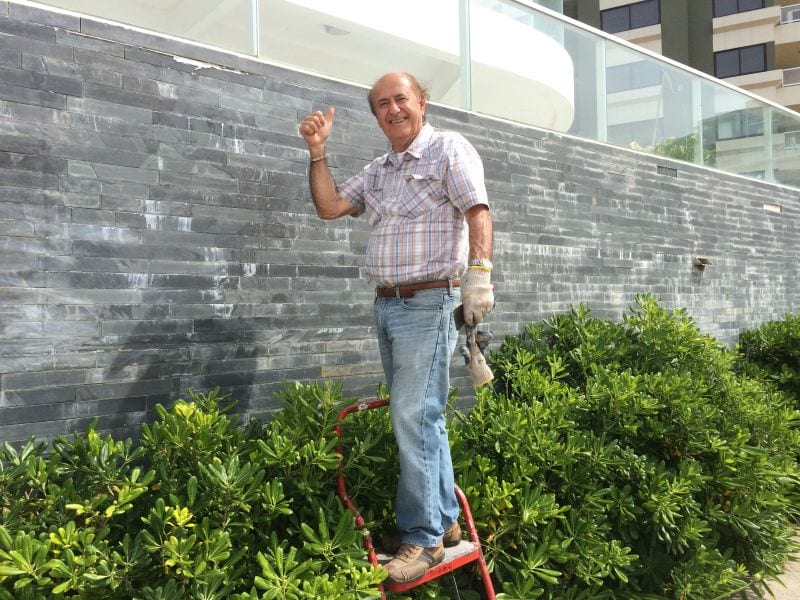Steve is my age.
He is standing on a ladder in work clothes scrubbing graffiti off pieces of slate glued to a concrete wall. We both agree it is a stupid place to put slate – stucco, or plaster painted, would make more sense. Still, vandals have marked the wall and the manager has to have it removed and Steve is the man hired to do it.
He tells me he is from Uruguay but migrated to the U.S., lived and worked there twenty five years. He came back to Uruguay because he still has a daughter here. For now, he works as a maintenance man for this apartment building but back in the states maintains large resort hotels and keeps commercial kitchens running.
“My wife went back last month,” he tells me, as he washes off graffiti. “I want to go back and drive my truck. I love it. I like Miami. My son has a construction business and a big house I can stay in .”
The conversation confirms that Uruguayans know all about the United States . A young man at the bus station , who spent five years trying to become a legal U.S. citizen, but couldn’t get accepted, expressed his belief that getting ahead is tough in Uruguay and immigration is a way to move up economic ladders.
“In the U.S.,” he said, “it is different. People think ahead.” Here, if your family is not important, you have difficulties.”
Graffiti is on the move around the world and is Punta Del Este’s a canary in a coal mine.
If they catch the culprits, Steve is pretty sure they won’t do a thing to them.
The cost of keeping people locked up has killed more than one government budget.
Search The Site
Translate This Page
Support Scott
See Scott’s Artwork!
Your purchase helps Scott continue his travels and he’ll reciprocate by taking you along in words, photos and videos!Recent Posts
Recent Comments
- scott on Fishing/Palo Duro Canyon
- rhett ladd on Fishing/Palo Duro Canyon
- scott on Strawberry Shortcake
- Charlie on Strawberry Shortcake
- scott on Prepper Money
- Alan on Prepper Money
- scott on Decorative Art
Archives
- April 2020 (28)
- November 2019 (1)
- October 2019 (5)
- September 2019 (3)
- August 2019 (8)
- July 2019 (18)
- June 2019 (8)
- May 2019 (21)
- March 2019 (52)
- February 2019 (22)
- November 2018 (18)
- October 2018 (9)
- August 2018 (1)
- July 2018 (10)
- June 2018 (11)
- December 2017 (11)
- August 2017 (12)
- June 2017 (18)
- April 2017 (10)
- March 2017 (33)
- February 2017 (33)
- January 2017 (2)
- October 2016 (2)
- September 2016 (49)
- June 2016 (1)
- March 2016 (2)
- February 2016 (8)
- January 2016 (16)
- December 2015 (50)
- November 2015 (57)
- October 2015 (7)
- September 2015 (10)
- August 2015 (11)
- July 2015 (5)
- June 2015 (6)
- May 2015 (8)
- April 2015 (6)
- March 2015 (8)
- January 2015 (29)
- December 2014 (30)
- November 2014 (83)
- October 2014 (3)
Categories
- Country (423)
- Belize (57)
- Costa Rica (10)
- Dominican Republic (55)
- Ecuador (56)
- Haiti (18)
- Mexico (48)
- Nicaragua (51)
- Philippines (30)
- Uruguay (98)
- Photo Shoots (10)
- Scott's Best Of (713)
- Animal Stories (86)
- Art, Music, Performance, Writing (122)
- Blast to the Past (111)
- Fish Stories (28)
- Friends & Family (88)
- Getting Around (81)
- Holidays, Events & Celebrations (50)
- Home Bases (69)
- Kids (47)
- Money Talk (118)
- Mother Nature Saddles Up (106)
- On the Beach (49)
- People (214)
- Places to Go & Things to See (185)
- Quirky (134)
- Shop 'til You Drop (57)
- Spirit Talks (194)
- Sports & Recreation (75)
- The Great Security State (108)
- What's to Eat (125)
- Working For a Living (154)
- States (293)
- Arizona (48)
- California (6)
- Colorado (36)
- Florida (10)
- Nebraska (6)
- New Mexico (150)
- Texas (37)
- Videos (66)




At first glance I thought this pic was of you! It sounds like you’re doing what I used to in mexico..i.e. go out walking and talk to the natives! Lol. In fact, I had a regular route and enjoyed trying out my Spanish and the Mexicans enjoyed practicing their english. Can’t even estimate how many hours I spent sitting with Tomas by the San Carlos marina gas docks chatting while he waited for boats to pull up! I especially like your posts with pictures of people! I remember when we were kids we thought having pictures with people in them…ruined them…..but now I realize that having people in pictures really makes them better! Keep your posts coming…..I loOK forward to see where you’ve been each day!
Hey Alan, Its funny, I came to the same realization a long time ago.My eyes are drawn to the people in the photos.Perhaps there is a deeper meaning in this.Relax, sit on a beach somewhere and reflect.